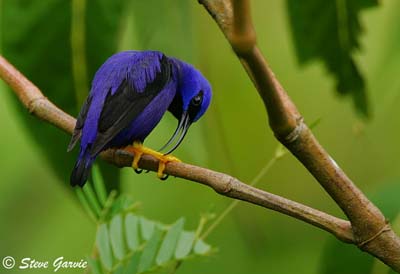
Purple Honeycreeper
Cyanerpes caeruleus
Passeriforme Order - Thraupidae Family
BIOMETRICS:
Length: 11, 5 cm; Weight: 12 g
LONGEVITY: 17 years
DESCRIPTION:
This wonderful small bird belongs to Tanager family. Male and female are very different in colour.

Purple Honeycreeper adult male has purplish-blue plumage almost on entire body. It has black wings. Blue tail shows two black central feathers and broad black tips on the other rectrices. Under wing coverts are black.
Male keeps its beautiful colour all year round.
Blue head is slightly paler than body. Lores are black. Chin and throat are black too, extending squarely on lower throat.
Long black bill is slender and down curved. Eyes are brown, included into the black mask. Legs and feet are bright-yellow.
Female is very different. She has yellow-green plumage on upper parts, with blackish flight feathers.
Underparts are heavily streaked blue-green and yellowish, with yellowish centre of belly. Undertail coverts are yellow and undertail feathers rather dark grey. Under wing coverts are dull pale yellowish.
Head is cinnamon, including forehead, lores and sides of the head. Crown and nape are finely streaked green and pale brown. Chin and throat are rather dark buff to reddish-brown. Cheeks are cinnamon, finely streaked with white. We can see a blue malar stripe.
Long, slender decurved bill is dark greyish. Eyes are dark brown, included into cinnamon mask. Legs and feet are greenish.
Juvenile resembles female.
VOICE: SOUNDS BY XENO-CANTO
Purple Honeycreeper utters tiny high-pitched “zzree” notes.
HABITAT:
Purple Honeycreeper lives in wet forest and edges, and in shrubby areas. It frequents the forest canopy and can also be found in cocoa and citrus plantations. It is visible up to 1400 metres of elevation, but mostly below 800 metres.
RANGE:
Purple Honeycreeper lives in northern South America, Colombia, Venezuela, southern Brazil and Trinidad. It also can be found in the Amazon Basin and in the Guianas.
BEHAVIOUR:
Purple Honeycreeper is gregarious and lives in small groups, but it can be seen in mixed flocks with other honeycreepers and dacnis.
It feeds on fruits, often hanging upside down in order to reach the seeds inside the open ripe fruits such as Clusia grandiflora.
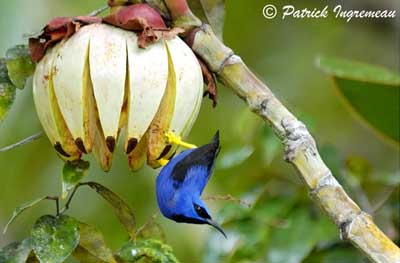
It also takes nectar from flowers, thanks to its long decurved bill. It gleans from foliage, catching invertebrates under the leaves, but it also flutters and performs sallies to the air, in order to catch small insects.
Purple Honeycreeper lives usually in the canopy, but it can be seen sometimes at lower level in flowering trees, and along the forest edges and shrubby areas. These birds are very active and restless.
Purple Honeycreeper can be aggressive during breeding season.
FLIGHT:
Purple Honeycreeper performs sallies for catching insects, and fluttering flights with rapid wing beats before to alight on the rim of an open fruit.
REPRODUCTION:
Purple Honeycreeper nests rather low in tree.
Female builds a small cup-shaped nest, with moss, small leaves and cobwebs. Interior is lined with fine rootlets.
Female lays two white eggs, spotted with dark brown. She incubates herself her eggs.
Young birds are very similar to female when they fledge.
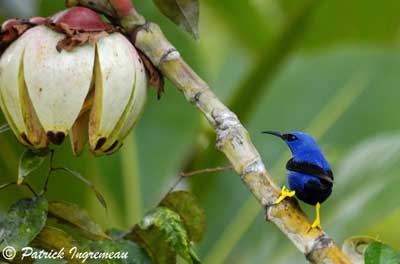
Fr: Guit-guit céruléen
All : Purpurnaschvogel
Esp : Copeicillo Violáceo
Ital : Cianerpe purpurea
Russe : Пурпурный цианерпес
Photographs « bird-fruit » by Patrick Ingremeau
TAMANDUA
Photographs by Steve Garvie
RAINBIRDER Photo galleries
Photographs of the female by Alfredo Colón
Puerto Rico Wildlife
Text by Nicole Bouglouan
Sources:
A GUIDE TO THE BIRDS OF COLOMBIA by Steven L. Hilty and William L. Brown
Princeton University Press – ISBN 069108372X
Arthur Grosset's Birds (Arthur Grosset)
Wikipedia (Wikipedia, The Free Encyclopedia)
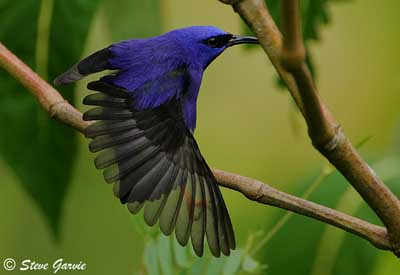
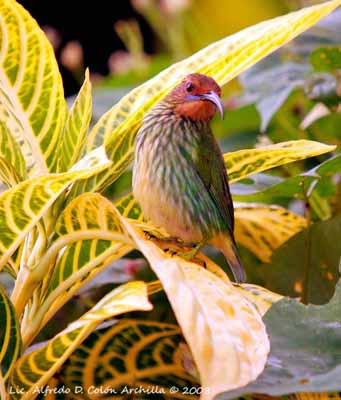
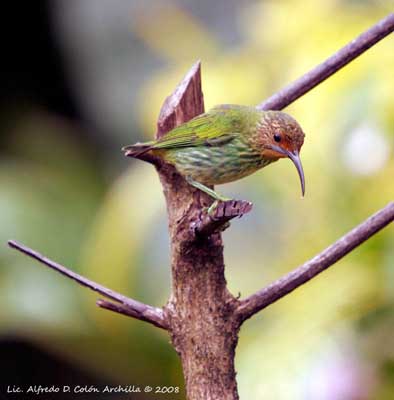
DIET:
Purple Honeycreeper feeds on fruit and berries, nectar from flowers, seeds from open ripe fruits and small insects.
PROTECTION / THREATS / STATUS:
Purple Honeycreeper is relatively common within its range, and the species is not threatened at this time.